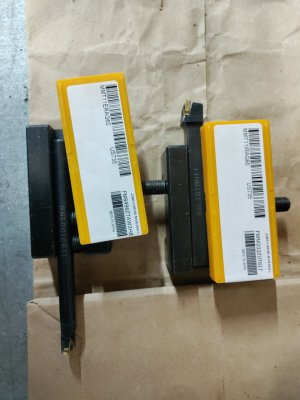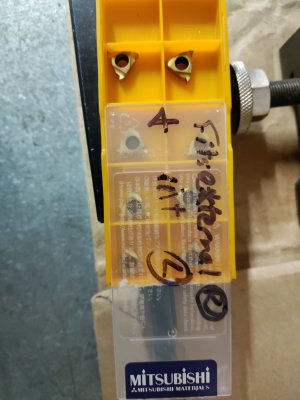Cutting upside down with the spindle in reverse while feeding towards the tailstock definitely works to cut right hand threads. In these pictures the top tool is set up to cut Joe Pi style. It also shows the Mitsubishi tool number of inserts for the tool.
-
Welcome back Guest! Did you know you can mentor other members here at H-M? If not, please check out our Relaunch of Hobby Machinist Mentoring Program!
You are using an out of date browser. It may not display this or other websites correctly.
You should upgrade or use an alternative browser.
You should upgrade or use an alternative browser.
Threading upside down
- Thread starter Jeffphillips
- Start date
- Joined
- Feb 21, 2022
- Messages
- 772
Invert the tool and cut at the front.That method doesn't work to well when you need to use a center for support.
The tool on the right side of the picture is set up Joe Pi style for internal threads. The tool is set up against a stop inside the bore and cuts the side of the bore furthest from you. The spindle is in reverse and you feed towards the tailstock.
When cutting external threads I set up my stop and cut a groove until it gives me my number over wires. It's much easier to read over two wires in a groove than three wires over the pitch. Now I can thread to zero instead of constantly measuring. Credit again goes to Mr Pieczynski. Truly a generous, intelligent machinist. We're lucky to share in his knowledge.
Those are cheap ass tools from banggood or AliExpress. I got the left and right hand external holders, as well as several sizes of boring style holders. All of them take either one of those inserts or the other. The tools work fine and the inserts last and last ( if you don't run the spindle forwards with an inverted tool.)
That method is the first outside the box method I saw. It works great if you have a cross slide that has t slots and lets you position your tool on the far side of the work. I wish my cross slide had that , heck I think they all should. Otherwise it works like you showed if you don't need the support of a center.
- Joined
- Feb 21, 2022
- Messages
- 772
It's just like a boring bar set past the centre. For a 1 inch diameter external thread it's only 1 inch further in than for a 1 inch internal thread.That method is the first outside the box method I saw. It works great if you have a cross slide that has t slots and lets you position your tool on the far side of the work. I wish my cross slide had that , heck I think they all should. Otherwise it works like you showed if you don't need the support of a center.
This method is not ideal where a long thread using a centre is required.
If I need a long male thread on the end of a shaft, I tap the end and fix a length of high tensile threaded rod in the female thread.



